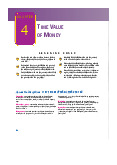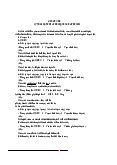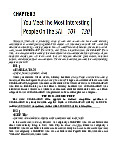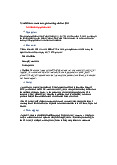



















Preview text:
Human Resource Management Unit 5 Unit 5 Recruitment Structure: 5.1 Introduction Objectives 5.2 Concept of Recruitment Importance of recruitment Process of recruitment
5.3 Factors Affecting Recruitment 5.4 Types of Recruitment Internal recruitment External recruitment 5.5 Summary 5.6 Glossary 5.7 Terminal Questions 5.8 Answers 5.1 Introduction
In the previous unit we learnt about job analysis and job description. We
have come to know that job analysis is an important aspect of human
resource planning. Once human resource plan is made and the job analysis
is carried out, then the organisation looks for skilled and qualified candidates
who can fill up vacant positions in the organisation. This process is known as recruitment.
The success and the failure of the organisation depend upon the capability
of the people working in that organisation. The most crucial task is to get the
right person for the right job at the right time. Without recruiting and hiring
the right person, even the best plans and strategies can fail. An organisation
achieves its objectives only because it has right people in the right positions.
It is not by chance that some organisations get people of their choice while others do not.
It is through recruitment that the organisation attracts the best candidates
and influences them to apply for vacancies there. Sometimes, an
organisation may find suitable candidates within the organisation an d
sometimes it may decide to look for better candidates outside. There is no
standard process of recruitment which is applicable to all organization. In Sikkim Manipal University Page No.: 7 6 Human Resource Management Unit 5
fact, every organisation uses its own customised system for recruitment. We
shall now look into the concept of recruitment in detail.
The ‘PacifiCare’ case depicts the best recruitment practices followed in the
organisation by focusing on the brand image.
Best Employer Brand: PacifiCare
PacifiCare realised the tremendous impact that a great brand can have
on recruiting in a healthcare industry that has all but ignored employment
branding. As a result, it has developed a formally managed employer
brand that is fully integrated with the core business strategy and brand.
The core business tagline is “Caring is good, doing something is better.”
This is supported by an employment brand tagline of “Envision, Innovate, and Accomplish.”
Best recruitment practices of PacifiCare are:
Full-time HR representatives work in the branding department and
they drive internal branding and employment brand integration.
Full-time HR representatives in the talent acquisition department
help to oversee all programs and messaging that affects the employment brand.
They negotiated a partnership between the brand team, the
advertising team and the talent acquisition team.
They use external market research to gauge target candidates’
perceptions in the marketplace in order to drive adjustments in program design and messaging.
Executives do not rely on the hard sell; they communicate honestly,
disclosing that PacifiCare is sometimes ’not an easy place to work’.
The branding team participates in programs that demonstrate the
brand by demonstrating results. A prime example of this approach is
PacifiCare’s development of the first-ever Quality Index of Hospitals.
[Source: http://www.ere.net/2006/03/20/six-best-practices-i - n recruiting/
(Retrieved on 22nd November, 2011)] Sikkim Manipal University Page No.: 7 7 Human Resource Management Unit 5 Objectives:
After studying this unit, you should be able to:
discuss the concept of recruitment
list the factors affecting recruitment
explain the types of recruitment 5.2 Concept of Recruitment
Recruitment is a linking function. It is a joining process in which it tries to
bring together job seekers and employers. The basic purpose of recruitment
is to finding the best talent in the job market and absorbing them in the company.
To have good recruitment, it is important to have three elements: i) Attractive compensation
ii) Better career opportunities
iii) Good organisational image or reputation (Brand image)
According to Yoder, “Recruitment is a process to discover the sources of
manpower to meet the requirements of the staffing schedule and to employ
effective measures for attracting that manpower in adequate numbers to
facilitate effective selection of an efficient working force.” In this definition
more emphasis is given on sources of recruitment so that we can get
effective and efficient work force to meet job requirements.
In the words of Byars and Rue, “Recruitment involves seeking and attracting
a pool of people from which qualified candidates for job vacancies can be chosen.”
Flippo says that, “Recruitment is a process of searching for prospective
employees and stimulating and encouraging them to apply for jobs in an
organisation.” According to this definition recruitment is a process of
gathering a pool of applicants. So it is a positive process.
Generally, the term ‘recruitment’ is used as a synonym for employment or
selection but it is not same. Recruitment precedes the process of selection.
Recruitment is often termed positive as it aims at stimulating large number
of people to apply for jobs in order to increase the hiring ratio i.e., the
number of applicants for a job. Selection, on other hand tends to be
negative because it aims at hiring the best among the lot and thus in the
process rejects a good number of those who apply for the job. Sikkim Manipal University Page No.: 7 8 Human Resource Management Unit 5 Today, everyon
e wants to attract and retain the best talent for their
company. Organisations like Infosys, Citi Bank, Johnson & Johnson and
Procter & Gamble etc. use employee stock option plan as a strategy to
attract and retain people in their organisation. Recently, Reliance Industries
have also announced their Employee Stock Option Plan (ESOP).
A firm must adopt a recruitment process so that they can get pool of
applicants in a cost effective manner. Through recruitment the firm makes
the first contact with the potential candidates. The recruitment policy of any
organisation is derived from its personnel policy. In other words we can say
that personnel policy provides guidelines for making recruitment plans.
There are three types of recruitment needs:
Planned: It arises due to the changes in the organisation and its policy.
Anticipated: It is a need which can be predicted by looking at the
changes in the internal and external environment.
Unexpected: It is a need which arises due to sudden deaths,
resignations, accidents or illness.
5.2.1 Importance of recruitmen t
The importance of recruitment is:
To attract and encourage candidates to apply for a job.
To help organisations in selecting the best suited candidates by creating a pool of applicants.
To determine the present and future requirement with the help of human
resource planning and job analysis.
It acts as a bridge between employer and job seeker.
It helps in meeting the legal and social obligations related to work force composition.
It helps in identifying the potential employees of the organisation.
It makes effective use of various sources and techniques for all types of jobs. Sikkim Manipal University Page No.: 7 9 Human Resource Management Unit 5
5.2.2 The recruitment process
The process of recruitment involves a series of steps. Each step is carefully
planned and executed because incorrect recruitment will lead to hiring the
wrong person for the job. The steps of recruitment process are:
i. Recruitment planning: Recruitment plan is derived from the human
resource plan, as discussed in unit 3. It involves preparing the job
analysis, job description and job specification. Recruitment strategies
are also planned to attract maximum number of qualified applicants.
ii. Recruitment sourcing: It is essential to know if the organisation would
want to identify applicants within the organisation or search for
applicants through external sources such as advertisements, websites etc.
iii. Attracting applicants: This is the most difficult and exciting part of the
recruitment process. The most difficult task is to attract high performing
candidates as most employers would try to retain them using variou s
strategies. Also, it would be difficult to source their resumes from
external sources. The organisation would have to devise methods by
which the potential candidates would get the information of the vacancies an
d induce them to apply for the jobs.
iv. Feedback: Feedback is important to know the quality and the success
of the recruitment process. It helps in planning recruitment policies in a
better manner for the future.
Self Assessment Questions
State whether the following statements are true or false
1. Recruitment is a process of stimulating and encouraging prospective
employees to apply for jobs in the organization.
2. Process of recruitment and selection are the same.
3. Recruitment needs are planned, anticipated and unexpected. Activity 1:
Design a recruitment process for attracting applicants for the position of
Marketing Executive in a premier advertising agency. Refer: Section 5.2 Sikkim Manipal University Page No.: 8 0 Human Resource Management Unit 5
5.3 Factors Affecting Recruitment
Let us see the factors that affect the recruitment process. Since recruitment
is the first step in identifying potential employees and there is a huge chance
of these identified candidates to be a part of the organisation, employers are
very careful with the recruitment policies. The management has to look into
all the factors that influence the recruitment process.
The factors that influence recruitment can be broadly divided into internal and external factors.
a) External factors influencing recruitment are:
i. Demand and supply: The organisation must look into the pool of
candidates that is available for a job position, both within and outside
the organisation. If the company has a demand for more
professionals and there is limited supply in the market for the
professionals demanded by the company, then the company will
have to depend upon internal sources by providing them special
training and development programs.
ii. Economic environment: The economic condition has great impact
on the recruitment of a company. As we have seen in previous units,
liberalisation, globalisation and privatisation hav e created demand
for different types of expertise from the potential employees, such as
ability to understand functions in international context, knowledge in
foreign languages, currencies etc.
iii. Social environment: Now a days organisations are becoming more
innovative in recruitment. One of the major causes is changes which
is taking place in our society. Social norms and values are
changing. From the traditional career attitude of job security and
safety, people now want faster pace of career growth and a job that
is challenging. More women have started working, so giving equal
employment opportunities have become more challenging for recruiters.
iv. Technological environment: The growth and innovation of
technology has become the norm now in our advanced world. With
the changes in technology the competencies required from the
potential employees have also changed. You may recollect after the
1990s there was a huge drive for computeriation in the various Sikkim Manipal University Page No.: 8 1 Human Resource Management Unit 5
banks across India. The old ledgers and account books were
replaced by computers. This change led to a huge cut in the intake
of employees in banks. Currently, you may find only three or four
employees in a local bank, who are proficient in using computers,
managing all banking activities. So, you can see that a small change
in technology made a big difference in the number of people required
and also there came a huge difference in terms of the skills and knowledge required from them.
v. Political – legal environment: The philosophy of the political
parties in power influences business practices. A pro-business
attitude on the part of government enables firms to enter into
arrangements that would otherwise not be allowed under a anti-
business philosophy. The legal environment serves to define what
organisations can and cannot do at a particular point in time.
Legislations such as the Factories Act 1948, the Apprentices Act
1961 defines the guidelines of recruitment, such as children below
14 years cannot be hired etc. The introduction of age discrimination
and disability discrimination legislation, an increase in the minimum
wage and greater requirements for firms to recycle are examples of
relatively recent laws that affect an organisation’s actions.
vi. Corporate image: Corporate image or reputation describes the
manner in which a company, its activities and its products or
services are perceived by outsiders. The social image of the
organisation also affects the recruitment practices. Organisations
that have positive corporate image have no difficulty in attracting
employees as they are perceived to be good places to work for. The
Economic Times and Great Place to Work Institute conducted a
survey in 2011 to find out the best workplaces in India that is,
companies that cared for its employees and vice-versa. More than
500 companies signed up for this year's survey, of which 471 met
the strict eligibility criteria. ‘Google’ was ranked first due to its
innovative compensation packages, freedom given to employees to
enjoy at workplace, encouragement towards risks and failures etc.
On the other side, the scam at Satyam destroyed the reputation of
the whole organisation and this has adversel y affected its whole hiring process. Sikkim Manipal University Page No.: 8 2 Human Resource Management Unit 5
vii. Unemployment rate: The rate of unemployment influences the
recruitment policies. If the unemployment rate is high then even
simple recruitment plan can work, as there is a large pool of
candidates who would be willing to work. On the other hand if
unemployment rate is low then specific plans are required to attract the best people.
viii. Competitors: The recruitment policies of the firm always have to be
competent in terms of the recruitment policies of its competitors.
Prospective employees give weightage to opportunities from
organisations that have maximum employee benefits. So, during
recruitment, management must highlight on the best practices of the
organisation. For example, Google attracts potential candidates by
emphasising on its flexible, project-based approach, equal
opportunities policy, innovative perks and benefits including 15 days of paid vacation every year.
b) Internal factors influencing recruitment are:
i. Organisational and recruitment policies: Organisations with a
philosophy of developing their human resources and of providing
opportunities for growth favor internal recruiting policies.
Organisations looking for fresh talent and new ideas would favor external recruitment.
ii. HR plan: Recruitment happens only after human resource
planning is framed. The human resource plan gives the detailed
framework on the recruitment policy that has to be adhe e r d to. It
gives details of what percentage of vacancies have to be reserved
for SC, ST, physically handicapped etc.
iii. Size of the organisation: If the organisation plans to increase its
operations or diversify or expand, it will require more manpower. At
the same time, if the organisation plans to downsize, it will restrict
the number of people required or make use of the existing
manpower to carry out functions.
iv. Cost of recruitment: No organisation would want its recruitment
process to be very expensive. Cho s
o ing the sources of recruitment
depends on the cost involved. The cost of recruitment also Sikkim Manipal University Page No.: 8 3 Human Resource Management Unit 5
influences if the recruitment has to be done internally or from outside the organisation.
v. Age composition of the workforce: If the majority of the
workforce is aged, then the organisation would prefer to hire
younger workforce from outside the organisation. If the workforce
in the organization is young, then the organisation would prefer to
train and develop its own employees to fit into vacancies.
vi. Wage and salary policies: One of the most important attracting
forces of any organisation is its wage and salary policies. People
are always attracted to the firms that pay well and at the same time
provide additional benefits such as medical insurance, travel
allowance etc. Intel India is known for its comprehensive
compensation package including base pay, bonus, commission,
shift premium, overtime premium, medical benefits including dental
benefits, access to recreation facilities, paid vacations, maternity
and paternity leaves, free counseling services etc. This
compensation policy, itself is a great motivator for people to apply for jobs.
vii. Nature of operations: The kind of job and its nature also affect
recruitment. For example, it is difficult to find a pool of interested
applicants for selling products door to door and meeting sales
targets. At the same time it is easy to find a large pool of
applicants for vacancies as Probationary Officers in banks. This
variation is seen due to the difference in the kind of work and
efforts required for the jobs. Selling products door to door involves
more physical strain and the employees have to face rejections from customers.
Self Assessment Questions Fill in the blanks
4. If the unemployment rate is ________ then a simple recruitment plan can also work.
5. If the majority of the workforce is aged, then the organisation would
prefer to hire younger workforce from ________ the organisation.
6. If the organisation is planning to downsize, the number of people required will be __________. Sikkim Manipal University Page No.: 8 4 Human Resource Management Unit 5 5.4 Types of Recruitment
When Pepsi recruits somebody they expect the p r e son to have a winner’ s
mindset, an ability to lead dramatic change, ability to stretch, ability to deal
with ambiguity, an orientation towards the business, a certain impact and
presence, flair and style, open and informal, aggression, innovative and high achievement.
In the same way, Rebook has its own criteria. They look for young
employees because their customers are young. A person with a sporty
attitude, a passion for the fitness business and reflect the company’s
aspirations, have the ability to get one’s hands dirty are some of the
desirable characteristics. The person should have the ability to cope up with
informality, a flat organisation and absence of hierarchy. One must be able
to take decisions independently and perform consistently with their clearly defined roles.
When we think of filling up a vacant position in the organization, we
definitely have to think of sources from where we can get suitable
candidates for the required number.
Some companies prefer recruiting internally that is, to find suitable
candidates within the organisation itself. At the same time, some prefer
external sources to recruit. They can be people working in other
organisation, students from different educational institutes, people registered in employment.
Let us look into each of these types in detail. 5.4.1 Internal recruitment
Internal recruitment requires identifying people already working in the
organisation to fill up vacancies. When organisations prefer internal recruitment, i
t puts a positive impact on loyalty, morale and motivation of the
employee. When an organization prefers internal recruitment, each time
there is a vacancy in the organization existing employees may be promoted,
transferred, upgraded to fulfill that vacancy. Any retired employee,
dependent of any deceased employee or retrenched employee also comes under internal sources.
The merits of internal recruitment are:
It can be motivational for employees. Sikkim Manipal University Page No.: 8 5 Human Resource Management Unit 5
It can improve the morale of the employees.
Internal candidates are known to the company so their suitability can be judged better.
It can generate and enhance loyalty, commitment, a sense of
belongingness and a feeling of security.
The employee can get a chance for advancement so the chance for job satisfaction is more.
Promotion can lead to increase in salary.
Minimum cost of selection.
The cost which occurs in training, orientation, induction and adaptation
of the new employee can be minimised .
Satisfies demands of trade unions.
Fulfillment of social responsibility of the organisation. More stable organisation.
The demerits of internal recruitment are:
The organisation is limited in choice. They are forced to compromise
with quality and settle for less qualified employees d e u to the limited pool of candidates.
It prevents the entry of external talented candidates. Recruiting
candidates outside the organization helps bringing in new and innovative
ideas. It may happen that existing employees fail to be innovative.
When employees are taken internally then it may be based on length of the service and not on merit.
Prejudice and personal preference or bias of higher officers can impact recruitment.
Internal recruitment can give rise to conflict within the organisation.
There can be a race for better position and it may lead to bitter relationship.
When a vacancy is filled by an existing employee, it creates another vacancy.
Thus, we can say that internal recruitment is cost effective and motivating
for the employees. At the same time, it restricts the organisation in terms of innovation and new ideas. Sikkim Manipal University Page No.: 8 6



